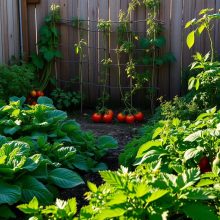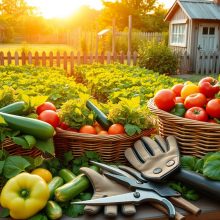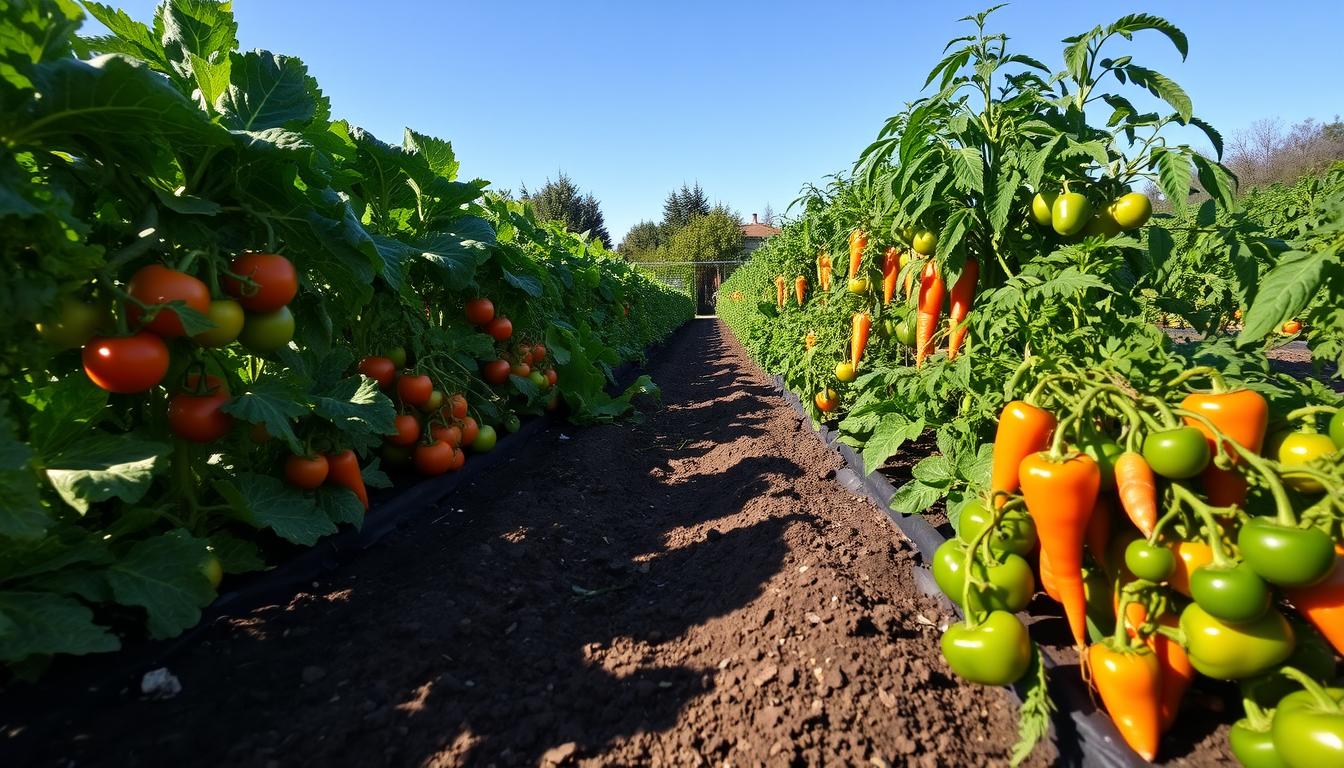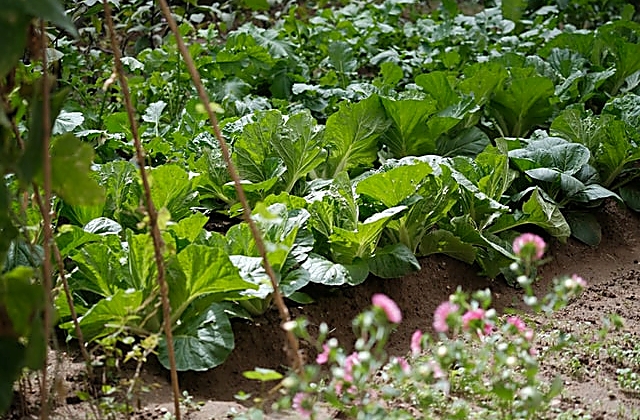Sustainable Vegetable Gardening: Secrets to a Lush, Eco-Friendly Plot
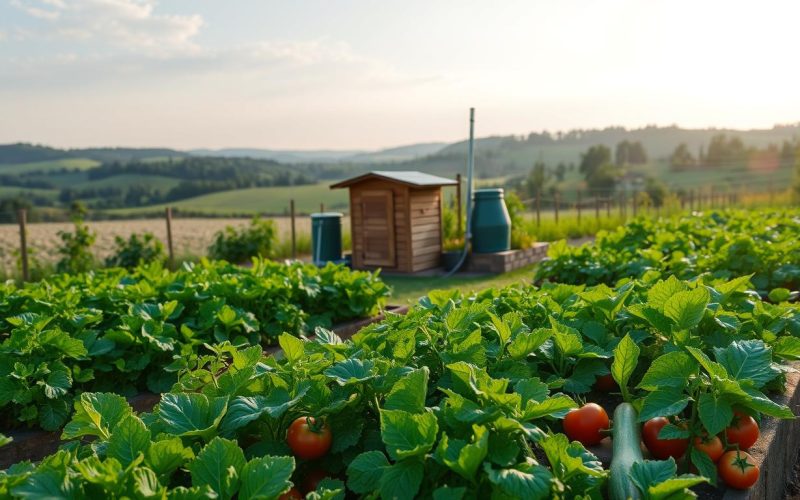
Sustainable vegetable gardening is a powerful way to grow food that’s good for us and the planet. The Environmental Protection Agency says eco-friendly gardening cuts pollution, saves water, and helps local wildlife.
Growing veggies sustainably is more than a trend. It’s a way to connect with nature and eat healthy food. By using sustainable gardening methods, we can make our gardens green and healthy for the environment.
Eco-friendly gardening lets us make a big difference in our own backyards. It’s about using fewer chemicals and supporting more wildlife. Sustainable gardening is a complete way to grow food that’s good for us and the planet.
Key Takeaways
- Sustainable gardening reduces environmental pollution
- Eco-friendly practices support local wildlife
- Home vegetable gardens can conserve water resources
- Gardening connects people directly with natural ecosystems
- Sustainable methods produce healthier, more nutritious vegetables
Understanding Sustainable Vegetable Gardening
Sustainable vegetable gardening is more than just growing food. It’s about caring for the environment and building strong communities. This approach creates balanced ecosystems that last for a long time.
At its heart, environmentally sustainable gardening is about working with nature. Gardeners who follow this path know their small garden can have a big impact on the environment.
The Essence of Sustainable Practices
Key principles of sustainable vegetable gardening include:
- Minimizing chemical interventions
- Preserving soil health
- Protecting local biodiversity
- Reducing carbon footprint
Environmental Benefits
Green gardens are vital for our planet. They clean the air, offer homes to wildlife, and fight climate change. They absorb carbon dioxide and help pollinators.
Community Impact
Sustainable gardening does more than just feed individuals. Community gardens teach, bring people together, and grow local food. They help neighborhoods become stronger and encourage healthy eating.
The Royal Horticultural Society says gardening boosts mental health, lowers stress, and strengthens bonds with nature.
Choosing the Right Location for Your Garden
Starting a successful vegetable garden begins with picking the best spot. Green gardening is all about knowing your outdoor space and making smart choices. These choices help your plants grow their best.
A great vegetable garden needs a few key things to thrive. Thinking carefully about your garden’s potential is key. It helps you make a space that’s both productive and eco-friendly.
Assessing Sunlight and Shade
Vegetables need the right amount of light to grow well. Most plants do best with:
- 6-8 hours of direct sunlight daily
- Protection from intense afternoon heat
- Consistent light exposure
Evaluating Soil Quality
Soil health is vital for growing veggies sustainably. Here’s how to check your soil:
- Purchase a home soil testing kit
- Check soil pH levels
- Assess drainage capabilities
- Examine organic matter content
Proximity to Water Sources
Good water management is key in green gardening. Choose a spot close to water for easy watering. Think about using rain barrels or a water collection system to save water.
By looking at these basics, gardeners can make a perfect spot for growing veggies. They can do it in a way that’s good for the planet too.
Soil Health: The Foundation of Sustainability
Starting a thriving vegetable garden begins with soil health. Sustainable gardening shows that healthy soil is key. It supports plant growth, improves nutrient absorption, and builds a strong garden ecosystem.
Techniques for Soil Testing
Soil testing is vital for gardeners to know their soil’s makeup. Organic gardening tips suggest several ways to check soil quality:
- Home soil testing kits for quick pH and nutrient checks
- Professional lab soil analysis for detailed results
- Checking soil texture by sight and touch
- Counting earthworms to gauge soil health
Organic Amendments for Soil Fertility
To naturally boost soil fertility, choose organic amendments. Gardeners can enrich their soil with:
- Compost made from kitchen and yard waste
- Aged animal manure
- Leaf mold and organic mulch
- Cover crops to replenish nutrients
The Role of Microorganisms in Soil Health
Microscopic life is essential for soil health. These tiny beings break down organic matter, create nutrient paths, and aid plant roots. By fostering a diverse microbial community, gardeners can create robust, productive gardens that flourish naturally.
Selecting Sustainable Seeds and Plants
Starting a sustainable vegetable garden begins with picking the right seeds and plants. The choices you make can greatly affect your garden’s health, productivity, and environmental impact. It’s important to know how to choose the best options for an eco-friendly garden.
Benefits of Heirloom Varieties
Heirloom seeds are great for gardeners who want a sustainable garden. These old-fashioned varieties bring:
- Rich genetic diversity
- Exceptional flavor profiles
- Better adaptation to local growing conditions
- Preservation of traditional agricultural heritage
Local and Native Plant Options
Native plants are key to eco-friendly gardening. They naturally fight off pests, need less water, and help local biodiversity. Choose plants that are native to your area’s climate and ecosystem.
Disease-Resistant Strains
Opting for disease-resistant plants cuts down on chemical use. Look for seeds and plants that can fight off common diseases. These varieties keep your garden healthy and support sustainable farming.
By picking seeds that fit sustainable gardening, you can grow a strong, productive, and green space.
Water Conservation Strategies in Gardening
Water management is key in making vegetable gardens sustainable. Gardeners can cut down water use and keep their gardens healthy with smart conservation. These methods aim to reduce water waste and use it more efficiently.
Rainwater Harvesting: A Smart Solution
Rainwater harvesting is a clever way to manage water. Gardeners can collect and store rainwater using simple setups like:
- Rain barrels connected to downspouts
- Underground cisterns
- Catchment systems around garden structures
Efficient Irrigation Techniques
Smart irrigation can cut down water use a lot. Drip irrigation systems are very efficient. They send water straight to the roots, saving up to 50% more water than sprinklers.
Mulching for Moisture Retention
Organic mulch is a great tool for garden sustainability. It covers the soil, helping:
- Keep water from evaporating
- Control soil temperature
- Stop weeds from growing
- Boost soil health
Using these water-saving strategies turns gardens into efficient systems. They support both the environment and garden growth.
Pest Management through Eco-Friendly Practices
Keeping your vegetable garden safe from pests is key to green gardening. Integrated Pest Management (IPM) is a smart way to fight pests without using harsh chemicals. It’s all about using natural solutions and planning ahead.
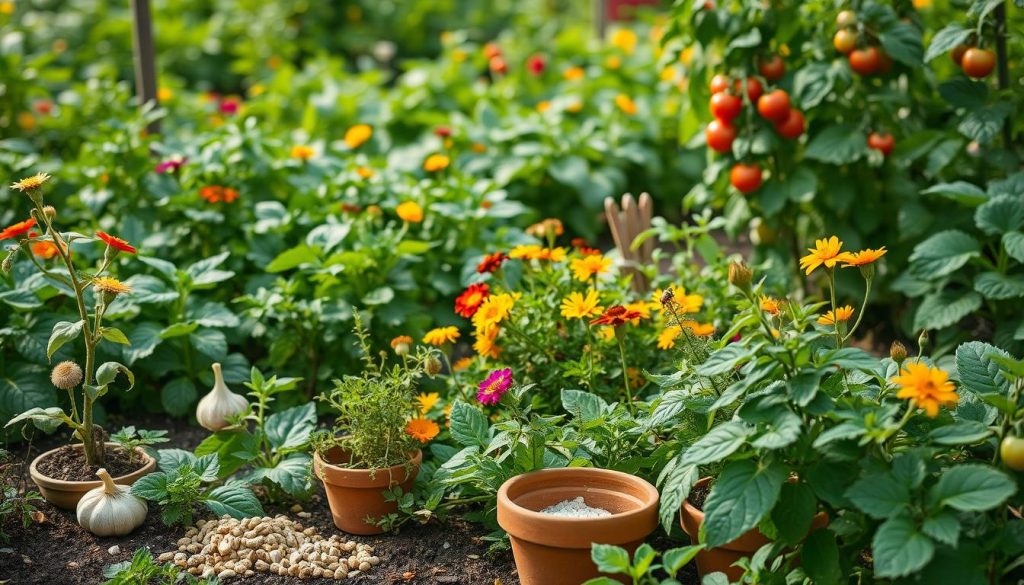
Understanding Integrated Pest Management
IPM is a mix of methods to keep pests under control. It’s about stopping problems before they start and keeping your garden balanced. Good IPM includes:
- Regular garden monitoring
- Identifying pest species accurately
- Implementing least-toxic intervention methods
- Creating ecological balance
Natural Predators and Beneficial Insects
Bringing in beneficial insects can help fight pests naturally. Ladybugs, praying mantises, and ground beetles are great helpers. Planting flowers like marigolds and yarrow can attract these good guys to your garden.
Homemade Organic Pesticides
You don’t need to buy expensive stuff to keep pests away. Simple homemade sprays can do the trick. Try making sprays with:
- Neem oil
- Garlic water
- Soap-based insecticides
- Vinegar mixtures
These green methods keep your garden healthy and productive. They also help protect the environment.
Fertilization Methods for Sustainable Gardening
Green gardening is key for a healthy veggie garden. It’s about using fertilizers that feed plants and protect the earth.
There are many ways to feed your veggies. Knowing the differences helps you choose the best for your garden.
Organic Fertilizers: Nature’s Nutrient Powerhouse
- Comes from natural stuff like compost, animal poop, and plants
- Slowly releases nutrients that make soil better
- Good for the planet and lasts long
- Keeps soil healthy for a long time
Composting: A Sustainable Fertilization Strategy
Composting turns kitchen and garden waste into great soil. It lets gardeners:
- Throw away less trash, up to 30%
- Make their own fertilizer for free
- Make soil hold water better
- Help good bugs in the soil
Crop Rotation for Nutrient Management
Crop rotation keeps soil fertile. By moving plants around, gardeners avoid nutrient loss and pests.
Using these methods makes your veggie garden grow well and stay eco-friendly.
Season Extension Techniques
Sustainable vegetable gardening lets gardeners get creative with their growing seasons. By extending harvest times, they can grow more and make their gardens more efficient. They use smart techniques to protect plants and create the best growing spots all year.
Utilizing Cold Frames and Row Covers
Cold frames are a great tool for gardeners. They shield plants from bad weather and can make growing seasons longer by 4-8 weeks. You can make cold frames from:
- Recycled windows
- Wooden frames
- Transparent plastic sheeting
- Insulated materials
Benefits of Greenhouses in Sustainable Gardening
Greenhouses take gardening to the next level by creating controlled spots for growing all year. Each greenhouse type has its own perks:
- Lean-to greenhouses for small spaces
- Freestanding structures for bigger gardens
- Portable hoop houses for easy moving
Strategic Planting Schedules for Extended Harvests
For a successful season extension, planning is key. Gardeners need to plan their planting based on the local weather, the types of crops, and how to protect them. Choosing the right plants and using succession planting can make your garden productive all year.
Embracing Biodiversity in the Garden
Biodiversity turns vegetable gardens into lively, thriving ecosystems. Eco-friendly gardening practices focus on the connections between plants, insects, and soil life. A diverse garden is more resilient, productive, and sustainable.
Creating a sustainable garden means understanding the web of life in your garden. Studies show that diverse plantings boost crop yields and fight pests naturally.
The Importance of Plant Diversity
Plant diversity makes gardens healthier by:
- Reducing pest vulnerability
- Improving soil nutrient cycling
- Creating natural pest management systems
- Enhancing overall garden resilience
Companion Planting Strategies
Smart companion planting boosts garden productivity. Some effective pairings include:
- Tomatoes with basil to repel insects
- Carrots alongside onions to deter pests
- Beans with corn for mutual support
Attracting Pollinators to Your Garden
Pollinators are key to a successful vegetable garden. Plant native flowers that offer nectar and support bees, butterflies, and beneficial insects. Strategic planting creates habitats for these vital garden helpers.
Creating a Sustainable Garden Layout
Designing a vegetable garden needs careful planning and smart thinking. Your garden’s layout is key to its success. It affects plant health and how well your garden grows.
Raised Beds vs. In-Ground Gardening
Choosing the right planting method is the first step in garden design. Raised beds are great for sustainable gardening:
- They help with soil drainage
- Let you control soil quality
- Reduce soil compaction
- Help roots grow better
Designing for Accessibility
Making your garden accessible means everyone can enjoy it. Add these features for inclusivity:
- Wide, stable paths
- Elevated garden beds
- Ergonomic tool storage
- Comfortable seating areas
Vertical Gardening Techniques
Use vertical gardening to make the most of your space. It’s perfect for small gardens. Trellises, hanging planters, and wall systems boost your growing area.
With a well-designed garden, you’ll have a space that’s productive, easy to get around, and good for the environment. It will help your plants and gardeners thrive.
Organic Weed Control Methods
Sustainable vegetable growing means managing weeds without harmful chemicals. It’s about keeping your garden healthy and productive. Effective organic gardening tips help prevent and control weeds naturally.
Manual Weeding Techniques
Hand weeding is a key organic gardening tip. It helps control weeds by removing them carefully. Here’s how to do it right:
- Pull weeds when soil is moist to remove entire root systems
- Use specialized weeding tools like hori-hori knives
- Remove weeds before they set seed
- Wear gardening gloves to protect hands during manual removal
Ground Cover Plants for Suppression
Planting ground cover plants is a natural way to control weeds. These plants not only suppress weeds but also benefit your garden:
- Clover helps fix nitrogen in soil
- Creeping thyme creates dense ground coverage
- Sweet woodruff prevents weed germination
Organic Mulching Options
Organic mulches are great for weed control and soil health. They can block up to 90% of weed growth and improve your garden:
- Straw mulch reduces weed emergence
- Wood chip mulches provide long-term coverage
- Cardboard layers block weed growth effectively
- Grass clipping mulches add nutrients to soil
Using these organic weed control methods takes time and effort. But, gardeners who use a mix of strategies will see the best results.
Gardening Tools for Sustainable Practices
Choosing the right tools can make your sustainable gardening better. Eco-friendly gardening tools help plants and protect the environment. These tools are key to a green and efficient garden.
Eco-Friendly Tool Options
Today, gardeners have many green tool options. Look for tools made from bamboo, recycled metals, or wood from sustainable forests. Some top choices include:
- Reclaimed metal hand tools
- Wooden-handled gardening implements
- Biodegradable planting containers
- Ergonomic tools made from recycled plastics
Maintenance Tips for Longevity
Good tool care makes them last longer and saves resources. Clean tools after each use and sharpen them often. Store them in a dry place to keep them in good shape.
Use natural oils to protect wooden handles. This prevents them from cracking and keeps them usable longer.
Tools to Enhance Efficiency
Invest in tools that make gardening easier and greener. Tools like digital moisture meters and precision irrigation systems boost garden productivity. They also use less resources.
- Water-efficient drip irrigation systems
- Solar-powered garden devices
- Precision pruning tools
- Compact composting equipment
By picking sustainable tools and caring for them, you create a green garden. This garden thrives with little harm to the environment.
Understanding Seasonality in Vegetable Gardening
Sustainable vegetable gardening means knowing the seasons well. Your garden’s success comes from working with nature’s rhythms. Choose the right crops and adjust your gardening all year.
Mastering the seasons turns your garden into a strong and fruitful place. To garden sustainably, understand each season’s special traits. Then, tailor your gardening to fit each time of year.
Choosing Seasonal Crops
Picking the right crops is key for a sustainable garden. Different veggies grow best in certain temperatures and light:
- Cool-season crops: Lettuce, spinach, peas, and kale
- Warm-season crops: Tomatoes, peppers, cucumbers, and squash
- Transitional crops: Broccoli, cauliflower, and brussels sprouts
Adapting Gardening Practices by Season
Each season needs its own gardening plan to keep your garden healthy and productive:
- Spring: Prepare soil, start seeds indoors, plan crop rotation
- Summer: Implement efficient watering, provide shade, manage pests
- Fall: Plant cover crops, prepare for winter, collect seeds
- Winter: Protect perennials, plan next year’s garden, maintain tools
Harvesting Techniques for Peak Flavor
Harvesting at the right time is crucial. It ensures your veggies taste great, are nutritious, and are good for the garden. Learn when each crop is best to pick for the tastiest and healthiest produce.
Community and Cooperative Gardening
Gardeners working together make sustainable gardening thrive. Community gardens are key to eco-friendly gardening. They change urban areas and build strong food systems.
Being part of local gardening groups has many benefits. It’s great for both new and seasoned gardeners. These groups offer chances to learn, share, and grow together.
Benefits of Local Gardening Collaboration
- Knowledge exchange with experienced gardeners
- Access to shared resources and tools
- Reduced individual gardening costs
- Enhanced social connections
- Increased food production capabilities
Starting a Community Garden
Starting a community garden needs careful planning and teamwork. Sustainable gardening methods are essential for these shared spaces.
- Identify a suitable location
- Gather interested community members
- Develop clear organizational guidelines
- Create a shared resource management plan
- Establish communication channels
Resource Sharing Strategies
When communities work together, eco-friendly gardening shines. Sharing seeds, tools, and workshops cuts costs. It also strengthens neighborhood bonds.
Community gardens are more than just farms. They are places for learning, socializing, and growing food locally.
Educational Resources for Sustainable Practices
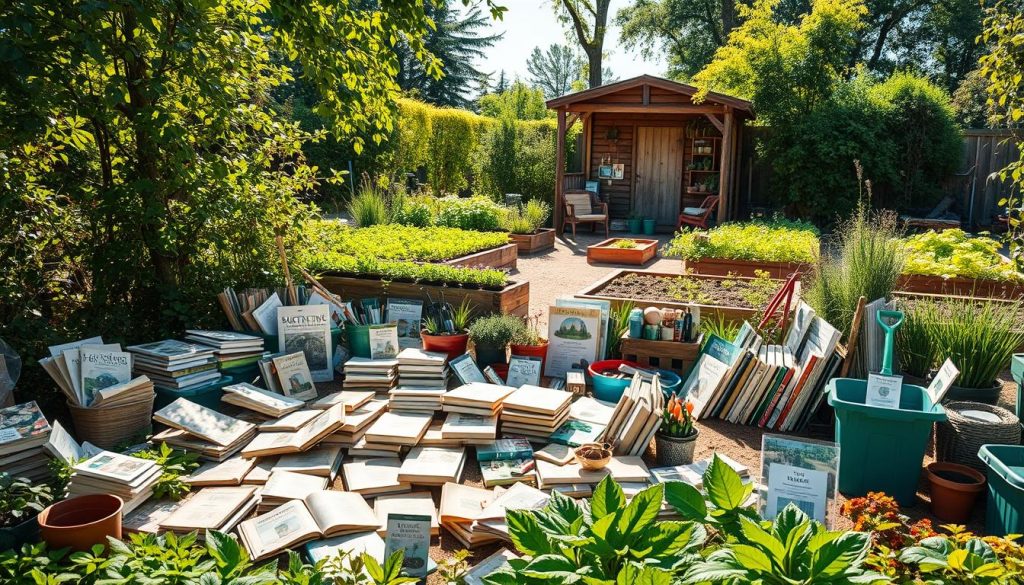
Learning about sustainable gardening can change how you grow vegetables. Now, it’s easier than ever to find organic gardening tips. Many educational resources are available for gardeners at every level.
Digital platforms have changed how we learn about gardening. Online courses and webinars let you learn from experts easily.
Books and Online Learning Platforms
- Udemy offers comprehensive sustainable gardening courses
- Masterclass features professional gardener training programs
- Local library systems provide free gardening e-books and digital resources
Local Workshops and Community Engagement
Community gardens and agricultural offices often have workshops. These events give you hands-on organic gardening tips. You can also meet local gardening experts.
- County extension service workshops
- Botanical garden educational programs
- Community college gardening classes
Networking and Skill Development
Meeting experienced gardeners can speed up your learning. Online forums, local clubs, and social media groups are great for sharing tips. You can also get practical advice.
Aspiring gardeners can find mentors, share techniques, and learn about new gardening ideas. These networks are full of opportunities for growth.
Future Trends in Sustainable Vegetable Gardening
The world of growing vegetables sustainably is changing fast. New technologies and smart gardening ideas are leading the way. These innovations mix old farming ways with the latest digital tools.
Urban gardens are growing food all over the world. People are using vertical farms, rooftop gardens, and small growing systems. These ideas turn empty spaces into places where food grows.
Now, there are special certifications for gardening that’s good for the planet. These help gardeners know how to grow food in a way that’s kind to the earth. They focus on saving water, keeping ecosystems healthy, and growing a variety of plants.
Technology is making gardening better and more efficient. We have systems that save water, drones to watch over gardens, and new plants that need less care. As the weather gets wilder, these tools will help us garden smarter for years to come.
